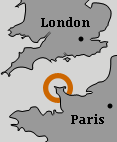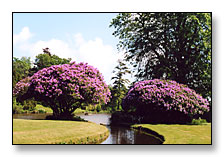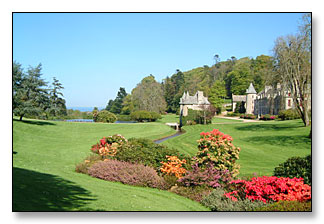|
|
|
|||||||||||||||||||||||||||||

|
||||||||||||||||||||||||||||||
 |
||||||||||||||||||||||||||||||
|
|
||||||||||||||||||||||||||||||
HistoryFamilies
Since building started 500 years ago, the history of the Chateau and Park of Nacqueville has been closely linked to those of the three families who have lived there:
BeginningsIn 1510 the ancient Norman family of Grimouville constructed the original building as a fortified manor with a protective wall, 6 metres high. This completely blocked out the view from the manor thus giving the owners of the time no interest in landscaping the surrounding countryside. Around 1700 the defensive wall was knocked down. With only the postern gate as the remaining reminder of the original defences, the owners had a beautiful view from the Chateau over the valley floor to the ornamental woods beyond. Creation of the Park
|
||||||||||||||||||||||||||||||
 |
|
|
Pruned rhododendrons, |
Only much later, in 183o, did Hippolyte de Tocqueville, whose wife owned the estate, decide to create a true park.
An English landscape gardener was commissioned to design a romantic park, taking in the three small valleys. Within a few years the work had been successfully completed:
![]() creating a lake next to the
Chateau and forming ponds, waterfalls and fountains,
creating a lake next to the
Chateau and forming ponds, waterfalls and fountains,
![]() clearing the main valley and
planting it with ornamental trees, flowering shrubs and exotic plants,
clearing the main valley and
planting it with ornamental trees, flowering shrubs and exotic plants,
![]() moving the entrance drive to
lead right up to the Chateau, and
moving the entrance drive to
lead right up to the Chateau, and
![]() extending the woodlands on
the surrounding high ground.
extending the woodlands on
the surrounding high ground.
These changes so impressed the political philosopher Alexis de Tocqueville, the author of the classic "Democracy in America", that he wrote to his friend G. de Beaumont in 1857:
"I was, the day before yesterday, at my brother Hippolyte's house. They
have lavished enough money and taste on Nacqueville to make it one of the prettiest places in
the world."

View down the valley to the sea
Post-war
Restoration
During the 2nd World War, the Chateau and the Park were occupied by the German army and then the Americans, who used the Chateau as an headquarters.
When Marcel Hersent (1895-1971) reclaimed the property in 1946, the whole place was in a disastrous state. Parts of the roof were missing, the interior was in ruins, the park had been devastated and the woods badly damaged. Over the next ten years, he completely restored the Chateau and put the Park and the woods back in order.
Proud of his work, in 1962 he opened the Park and the Chateau to the public.
Consolidation
In 1971, Marcel's daughter Jacqueline, who had married Francois Azan in 1946, inherited the property. For the next 29 years they dedicated themselves to keeping the estate in perfect order, preserving its harmony and charm.
Today
In 2000, the property passed to their daughter, Florence. With her husband Thierry d'Harcourt and their three children Hildevert, Alban and Quitterie, they left their Australian home of 12 years to settle in Nacqueville and pursue the task of the 18 previous generations who have over 5 centuries been the owners of Nacqueville.
More about the family and the other people involved in opening Nacqueville to the public can be found under About us.
 |
||
© T. & F. d'Harcourt, 2002-24. All rights reserved
|
|
rdy4web.jpg)